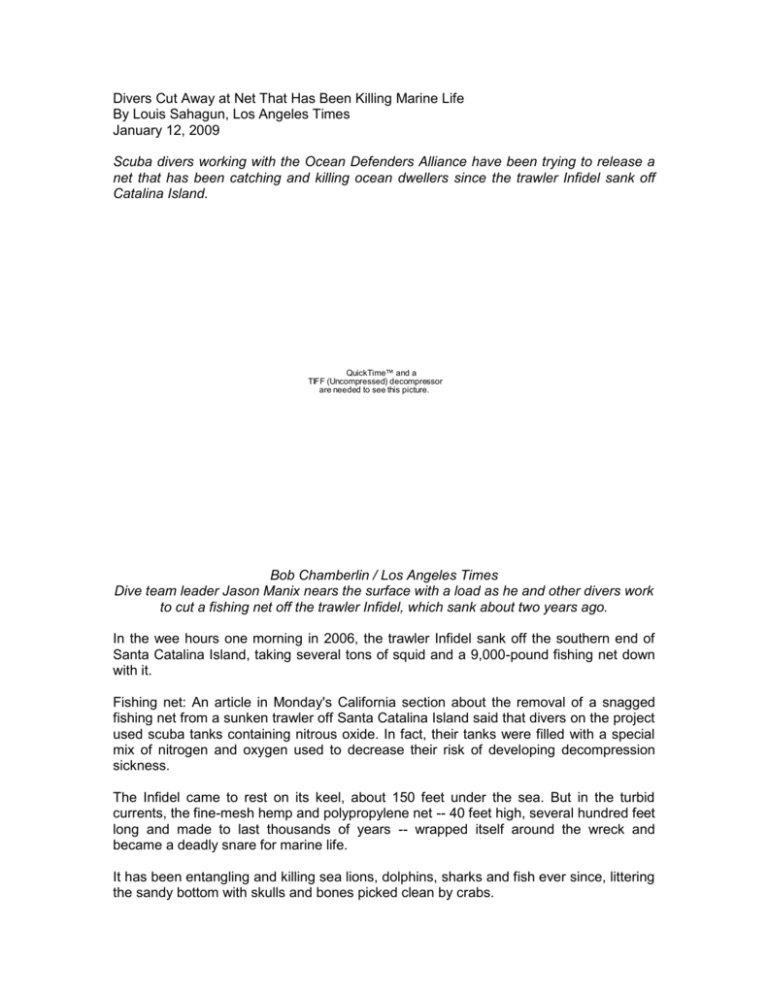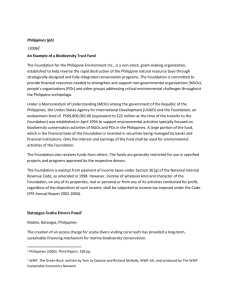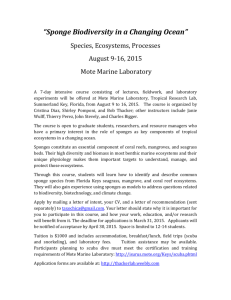divers cut away at net that has been killing marine life
advertisement

Divers Cut Away at Net That Has Been Killing Marine Life By Louis Sahagun, Los Angeles Times January 12, 2009 Scuba divers working with the Ocean Defenders Alliance have been trying to release a net that has been catching and killing ocean dwellers since the trawler Infidel sank off Catalina Island. QuickTime™ and a TIFF (Uncompressed) decompressor are needed to see this picture. Bob Chamberlin / Los Angeles Times Dive team leader Jason Manix nears the surface with a load as he and other divers work to cut a fishing net off the trawler Infidel, which sank about two years ago. In the wee hours one morning in 2006, the trawler Infidel sank off the southern end of Santa Catalina Island, taking several tons of squid and a 9,000-pound fishing net down with it. Fishing net: An article in Monday's California section about the removal of a snagged fishing net from a sunken trawler off Santa Catalina Island said that divers on the project used scuba tanks containing nitrous oxide. In fact, their tanks were filled with a special mix of nitrogen and oxygen used to decrease their risk of developing decompression sickness. The Infidel came to rest on its keel, about 150 feet under the sea. But in the turbid currents, the fine-mesh hemp and polypropylene net -- 40 feet high, several hundred feet long and made to last thousands of years -- wrapped itself around the wreck and became a deadly snare for marine life. It has been entangling and killing sea lions, dolphins, sharks and fish ever since, littering the sandy bottom with skulls and bones picked clean by crabs. On Sunday morning, a team of volunteer scuba divers armed with filet knives and shears began cutting away the danger. Guided only by flashlights, they sliced off swaths of the netting, which they then attached to inflatable air bags that rose to the surface. From there, the netting was hauled aboard the 75-foot trawler Captain Jack. The potentially dangerous mission was organized by Ocean Defenders Alliance, a nonprofit marine conservation group based in Huntington Beach and founded by Kurt Lieber. Rising out of the clear blue water, Lieber removed his mask and said, "It's one of the spookiest things I've ever seen. "It's a huge vessel encased in a net -- anything that swims into it gets trapped in its billows," he said. "The enormity of the task before us is daunting. We're making a little bit of difference today. But we have a long way to go." The team of seasoned divers included Avalon Mayor Bob Kennedy, owner of Catalina Scuba Luv, and employees of three other scuba stores on the island. Also on board were UC Irvine marine biologist William Cooper, nature-film maker Tony Christopher and Avalon harbor patrolman Jason Manix. Use of the 200-ton Captain Jack was donated by its owner, Mike Hoover. "We've all put aside our differences as competitors in the scuba industry . . . and united behind a common cause," Manix said. "Catalina is our backyard, and we don't want this kind of garbage in it." Cinde MacGugan, 36, a store manager at Catalina Diver Supply, led a group of team members who sliced off roughly 200 square yards of netting within 30 minutes. Removing her flippers after spending 60 minutes under water, MacGugan said: "We got a lot of wins on that one -- but it was one of the scariest dives in my life. "Once you start cutting, visibility drops from 30 feet to zero because the water clouds up with particles and tiny creatures that get shaken loose," she said. "At one point, I was frantically cutting off pieces of netting when one or more was tugged upward by an air bag. "I looked around and discovered that I was in a kill zone. There were tons of bones and a bunch of sea lion skulls by the propeller and a whole shark caught in the fabric. My fellow divers were close by and had their eyes on me as I backed out into the clear." The limit for normal scuba diving is 120 feet beneath the surface. But because of the depth of the wreck and the 20 minutes per dive needed to hack off appreciable portions of fishing gear, the divers relied on tanks filled with a special nitrous oxide mixture that enabled them to spend more time at the bottom while reducing the chances of contracting the bends, or decompression sickness. By midafternoon, the team had raised about 800 square feet of netting, which was piled in a corner of Captain Jack's big wooden back deck. 2 Wind-driven waves bucked the hull as several children on board plucked a variety of critters -- strawberry anemones, sea cucumbers, brittle stars, shrimp, crabs and snails -off the retrieved netting and tossed them back into the ocean. Kennedy speculated that it would take as many as nine more diving days to retrieve the bulk of the net after the Infidel teeter-tottered into the sea near Church Rock, a natural landmark at the southern end of the island and about 22 miles from the mainland. Shortly after the vessel went down, its owners called Kennedy for help, initially thinking their biggest problem was an underwater fuel hazard. Eventually, he said, "the owner's insurance company paid him for the value of the boat," but it remained a hazard under the sea. "The net draped over the Infidel like a circus tent," he said. "Worldwide, there are many thousands of derelict killer nets like this one, abandoned and adrift in the in the seas," said marine biologist Cooper. "In one case, abandoned fishing gear in Puget Sound was studied for 10 years. An estimated 30,000 marine mammals, fish and birds were killed each year in it." Shaking his head in dismay, Cooper added, "There seem to be no laws when it comes to dumping in the open ocean." louis.sahagun@latimes.com 3





